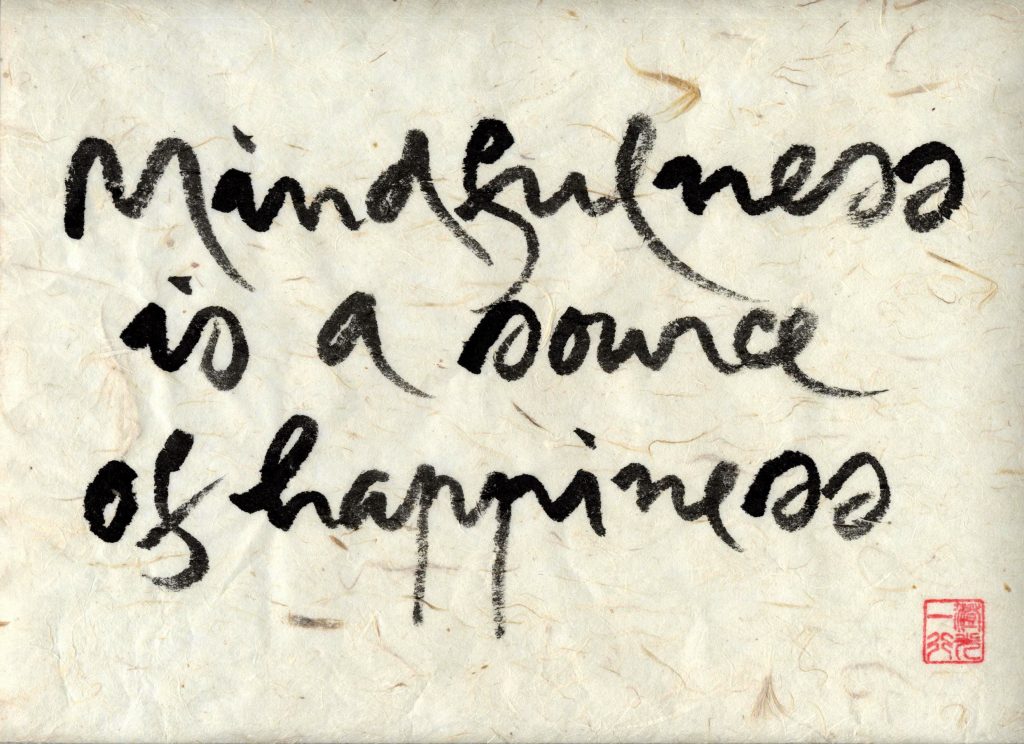
Begin
Start your mindfulness journey here

Mindfulness can be described as “being aware of what is happening inside and around you in the present moment.” The key Plum Village teaching is that, through mindfulness, we can learn to live happily in the present moment—as a way to truly develop peace, both in one’s self and in the world.
As we cultivate more awareness of our breath, our body, our feelings and our thoughts we gain insight into what causes our happiness and what causes our suffering. We see more clearly how to act to create peace and wellbeing for ourselves and those around us. We see mindfulness as part of a path, beyond a tool or technique, that requires training and practice.
Mindfulness comes from the Buddhist tradition yet is a practice that is available to people of all faiths and none.

Using the awareness of the breath and body in sitting or walking meditation, we can gradually learn to still our mind by coming home to the present moment.
When we are fully present, it becomes possible to cultivate feelings of happiness and joy. Just bringing our attention to the abilities of our body can be enough to feel gratitude and appreciation.
When we have practised returning to the present moment we are better equipped to deal with difficult emotions such as anger, fear and anxiety. Using the breath as our anchor we can start to weather emotional storms.
The stillness from meditation gives us space to notice and observe our thoughts, identify repetitive unhelpful thought patterns and start to untangle mental knots.
Ultimately mindfulness can help us to see more clearly that all things are impermanent and subject to change. Seeing this clearly lets us live with more freedom. We can also look deeply into our ‘interbeing’, our connection with all other people and with the world around us. This helps us to feel less alone, to understand that our habits have causes and conditions and to see how our words and actions impact others and the world around us.
Plum Village Monastery in France is the first monastic practice center founded by Thich Nhat Hanh in the West. It is where Thich Nhat Hanh developed his iconic light and gentle style of mindfulness practice that is now familiar around the world. Numerous high-profile mindfulness programs—including Google’s Search Inside Yourself course—are based on the Plum Village approach.
Plum Village Mindfulness has four key features:
While mindfulness is widely considered to be a method of stress relief, Thich Nhat Hanh has long taught that mindfulness is not a tool but a way of life. The Plum Village tradition uses the Five Mindfulness Trainings, a concrete expression of Buddhist teachings, to bring an ethical and spiritual dimension to decision making. Mindfulness is also applied to all aspects of life, including sitting, walking, eating, speaking, listening, emailing, and working.
At the heart of our tradition is our approach to community. We see that applying mindfulness to our daily life is not always easy. With the support of a spiritual community (or “Sangha”), the challenge can be lightened and it becomes possible both to transform our suffering and to cultivate joy and happiness. We can build community in workplaces, schools, and health care environments, and together bring positive change to society.
Amidst the devastation of the Vietnam War, Thich Nhat Hanh and his colleagues found a way, with mindfulness, to actively help those most in need without losing their own spiritual practice. “Engaged Buddhism” was born—a practice that is engaged with the challenges of our time, and in which personal spiritual growth and service to society go hand in hand. Today, many thousands of people worldwide follow in Thich Nhat Hanh’s footsteps by practicing Engaged Buddhism.
Thich Nhat Hanh has established a monastic order that is dynamic, youthful, and engaged. It is also the largest Buddhist monastic community in the West. In Plum Village practice centres around the world, the monks and nuns create a peaceful, joyful, and healing environment where visitors can take refuge and immerse themselves in mindfulness practice. The monastics’ commitment to a life of simplicity, harmony, and spiritual training ensures that Thich Nhat Hanh’s living teachings will be carried far into the future.
Sign up to ‘Here and Now’ to receive the latest Plum Village news, mindfulness inspiration, and information on retreats and courses.